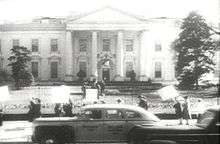American Peace Mobilization

The American Peace Mobilization (APM) was a peace group, officially cited in 1947 by United States Attorney General Tom C. Clark on the Attorney General's List of Subversive Organizations for 1948, as directed by President Harry S. Truman’s Executive Order 9835.
History
APM was created in 1940 from the remains of the American League for Peace and Democracy (previously known as the Comintern affiliate American League Against War and Fascism) and the Hollywood Anti-Nazi League,[1] both of which were dissolved following the signing of the Molotov-Ribbentrop pact in 1939.
Now on stable terms with Nazi Germany, the Soviet Union’s focus turned from overt anti-Fascist militancy to “peace.” In the midst of the London Blitz and the Battle of Britain, APM agitated for a cut-off of “warmonger” President Franklin Roosevelt’s Lend-Lease program, and any other U.S. aid to the U.K.[2]
The APM, however, abruptly ended its 1,029-hour non-stop peace demonstration in front of the White House on June 21, 1941 — one day before the Nazis invaded the Soviet Union.[3] Reversing its position, APM now demanded immediate U.S. entry into the war.[4] APM changed its name yet again, to the American Peoples Mobilization.[5]
The executive director of APM at the time of this reversal was Frederick Vanderbilt Field; Congressman Vito Marcantonio was one of its vice chairs.
While the Communist Party and its various "pro-peace" front organizations completely reversed their position on the war the moment the pact was violated, the non-interventionists of America First continued their opposition until the U.S. was attacked on December 7, when even the previously pro-Nazi German American Bund endorsed war on the Axis.
During the Cold War, the group re-discovered pacifism as the National Committee to Win the Peace in demanding nuclear disarmament, and U.S. and British withdrawal from Palestine, China, the Philippines, and Greece.[6][7]
Goals
The program of the organization was defined in its "5 Planks to Defend America" as:[8]
- Get out and stay out of the European War.
- Defeat Militarism and Regimentation. Repeal Conscription. No M Day for the American people.
- Restore the Bill of Rights. Restore free speech, freedom of assembly, freedom of thought. Take special privilege away from the top and give it back to the whole American people.
- Stop War Profiteering. Put lives ahead of profits. Put profits last on democracy's list. What helps democracy helps you.
- Guarantee a decent standard of living for all. Work for more social and labor legislation. End discrimination.
Subversive Activities Control Board
The Subversive Activities Control Board concluded that the Party functionary serving as executive secretary of the American Council, stated that the American Peace Mobilization and the American Council would be mere hollow shells without the Communist Party USA and that the Party 'had to use these means to weld the people into a fighting unit so that they could wrest the power from the dying ruling class.'[9]
References
- ↑ Alan Casty (3 August 2009). Communism in Hollywood: The Moral Paradoxes of Testimony, Silence, and Betrayal. Scarecrow Press. pp. 44–48. ISBN 978-0-8108-6949-3. Retrieved 3 June 2013.
- ↑ Picketers Picketed, Time, June 2, 1941
- ↑ "White House Pickets Stop At 1,029 Hours," Washington Post, June 22, 1941
- ↑ Purely for Peace, Time, July 14, 1941
- ↑ American Peoples Mobilization Collected Records, 1940-1941, Peace Collection, Swarthmore College.
- ↑ The First Loyalty, Time, March 31, 1947
- ↑ Win the Peace for Whom? Time, September 16, 1946, (What is a Front?, response from BGen. Evans F. Carlson)
- ↑ Volunteer for Liberty, newsletter of the Abraham Lincoln Brigade, February 1941, Volume III, No. 2
- ↑ Reports of the Subversive Activities Control Board, United States Government Printing Office, 1966. Vol. 1, pg. 491.
